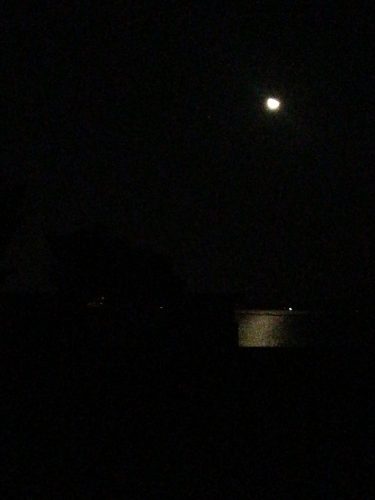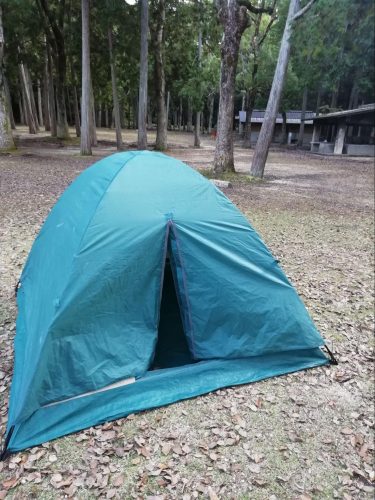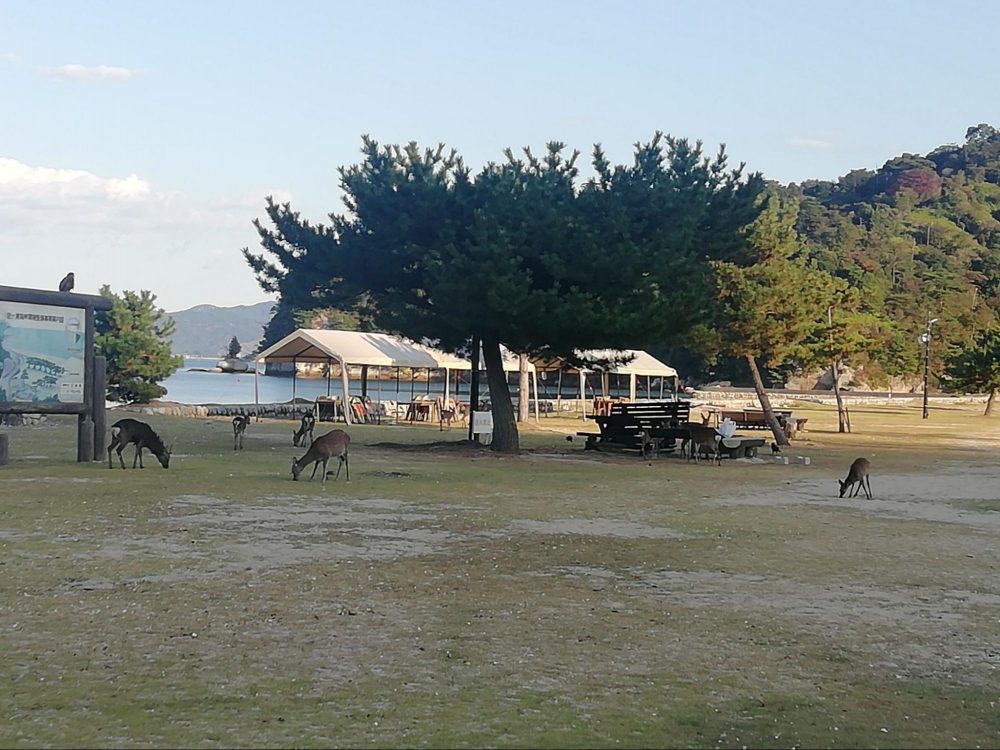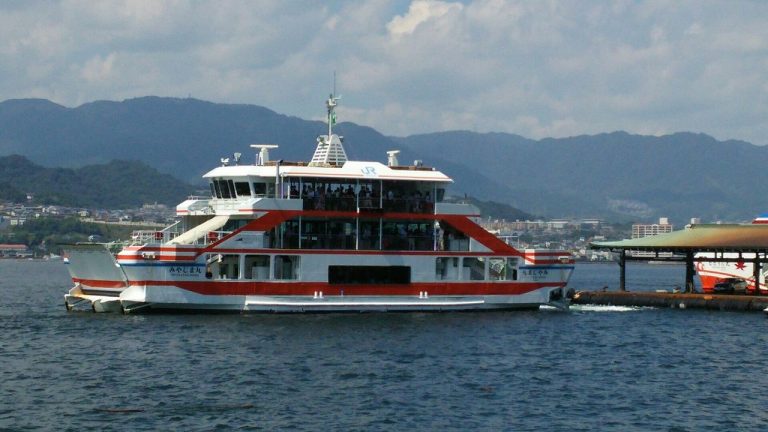100 Stories
DEER, A TENT, A VIEW, AND MORE DEER – Camping on Miyajima
Harkening back to my childhood, I remember fondly being at state campground with my family, and early in the morning my father and I discovering a deer on the golf course. Well, how about discovering well over 20 deer on a soccer field? Another camping thrill from long ago was watching my older brother get a raccoon to come close enough to take some bread from his hand. Well, how about deer so bold as to be coming right up to your tent? This is camping, Miyajima-style. Sharing your night with deer, deer and more deer.
Tsutsumigaura Natural Park, on the island of Miyajima, is a campground and facility that has all you need in a campsite and possibly much more. Especially the aforementioned deer. The adventurous, as I was drafted to be, can simply pitch a tent (available for rental) and be good to go. Those who prefer more creature comforts can rent some rustic but quite nice cabins. Beyond the sleep location, though, there are barbecue pit option, tennis courts, a beautiful ocean view looking across at the city of Hiroshima’s skyline, a weekend party restaurant experience, a lovely pond for meditation and beauty, and more. And by more I mean more deer. Ha ha. It’s impossible to oversell how linked camping here and the deer are.
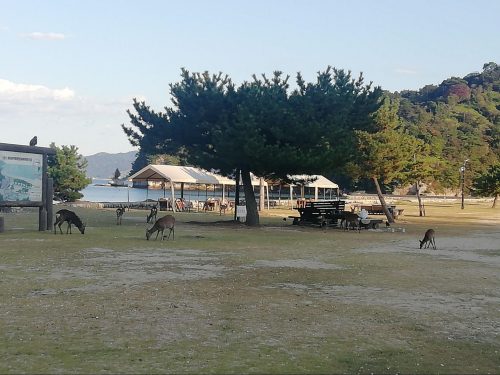
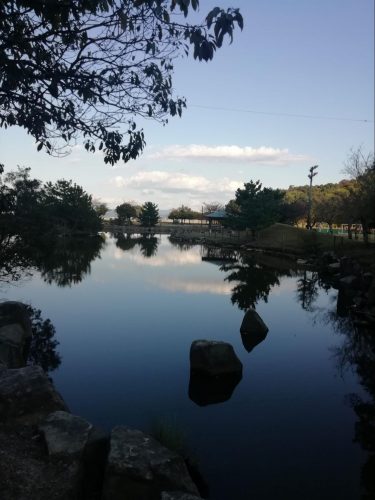
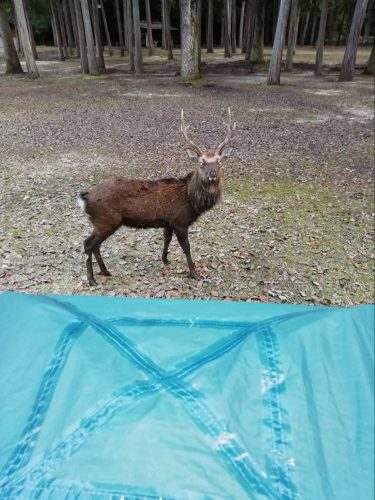
MAKING PLANS
Although there is some open area designated for camping, and you are allowed to bring your own tent, it is still necessary to notify of your intent to camp there and to pay for a camp site. Off season, this can be as simple as showing up at the front desk with your gear in hand. Peak season reservations might be a good idea. Also, while Miyajima is not overly large, the campsite is roughly three kilometers from the pier, so you’ll need to plan how to get there. While the campsite does have three shuttle busses, and advertises about pickups, when I called off season and inquired on how to get there, no shuttle was offered and instead I was told to take the local Miyajima bus (300 yen, and a strange schedule with less than one bus an hour going to the site) or a taxi (a little over 1,000 yen).
Being an obstinate cuss, I walked it. One the way there I was spotted by a driver who “had seen me back at the pier”, and was graciously offered a ride. That is when I discovered that though the road remains close to the coast the entire way, it’s a far hillier hike than I had imagined. However, jumping ahead to my return, I needed to depart on the 8:30 ferry, but the first bus from the campsite in the morning is not till nine a.m. So this time I did have to walk the full route. It was not so tough, and I managed it in less than a half hour.
Officially the site requires check-in before 5 p.m., and lists check-out as after 10 a.m. The website claims “full time staff are stationed on the premises to quickly and properly attend to such emergencies as bad physical conditions, injuries, and accidents.” That seems to also a be a peak season versus off season issue, however, as I was told the staff was gone after 5 p.m. and there was no staff around that I could determine who could have aided me in the night, if there had been need. Of course, being well into autumn when I camped, there was only one other camper there either, so surely full-time staff is not feasible for the site at that time.
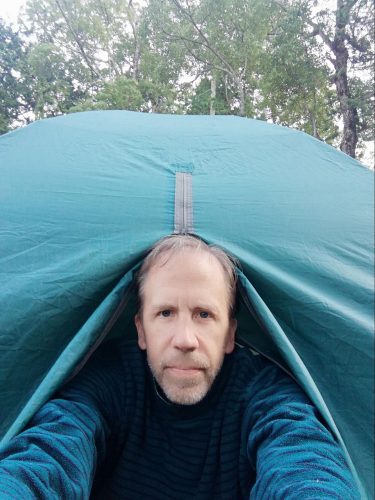
THE FACILITIES
There are two-bedroom family cabins available for rent. Some have been more recently remodeled, so they are listed on the website as “old” cabins and “new”. A sign on site claims that after a “renewal” the family cabins are available for two or more people for around 10,000 yen a night. Additional charges for more people. Meanwhile cabins for even just one person are available at 3,400 yen a night. They are barrier free, to be enjoyed by even the elderly or disabled, and feature one room with western-style twin beds, and one room with a Japanese-style tatami (straw mat) flooring with Japanese-style futon mattresses. There is also a kitchen with a fridge and a stove, an annexed bathroom, and table just in front of the door for outdoor BBQ enjoyment. There are also group cabins that can sleep up to 14, or up to 24 persons, using double bunk bed rooms. Great for planning a company or school outing.
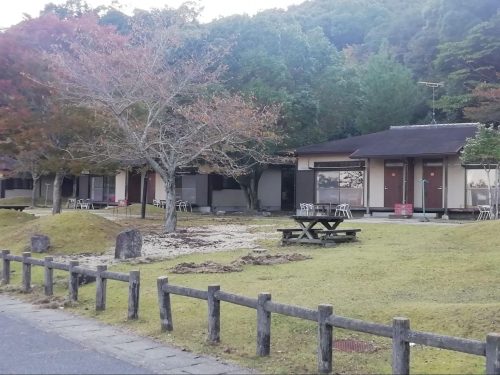
If, like me, you’re thinking camping = tent, not cabin, it is actually just 900 yen for a camping site, if you have brought your own tent. When I stayed there was one other couple camping, and their tent looked big enough to park a car inside. But they paid the same 900 yen fee only. Great deal. If you don’t have a tent, or, again like me, have a tent but didn’t want to lug it there on the ferry just to sleep in alone, they have tents for rent at 2,800 yen. So you’ll pay 3,700 yen. Still much cheaper than a hotel room, and you get the nature and the deer to enjoy as well. More on my experience in a minute.
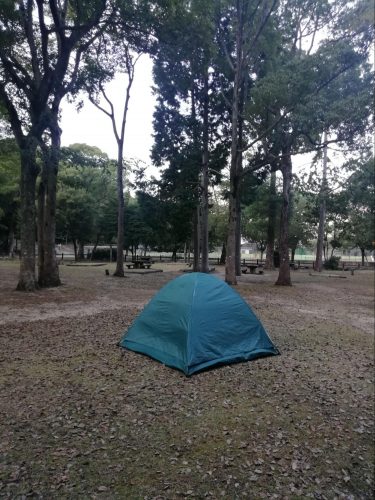
The campsite is also heavy into the idea that campers want to barbeque. There are barbecue ovens and picnic table all around the site. And the front desk sells three different sets of meat, and one of seafood, so you don’t even need to go to a supermarket before arriving (although bringing your own food is also acceptable). The meat and seafood platters run between 2 and 4,000 yen. They also seem to offer side dishes including a pizza, and beer for the adults in your group. All food purchases must be done before 5 p.m., however. Small grills and charcoal are also available.
For campers and cabin dwellers alike, the site also rents portable gas stoves, frying pans, a kettle, a toaster, a lantern (battery sold separately was a surprise), a folding bed, sleeping bags, badminton equipment, tennis equipment, bicycles, access to a beach volleyball net and court, and fishing gear. Also access to a washing machine and detergent is possible. And also a shower – though the website says “hot water” shower for 420 yen, on location it appeared to be cold water only and a hard pass. But it’s there is you desire. The site also will sell you logs for a bonfire, with options of doing it near your campsite or on the beach.
Finally, there are 3-hour fishing cruises available from a small boat that docks near the campsite. It advertised as 3,800 yen per person for up to seven people. There is also an on-site restaurant, the Oyster BBQ House, that boasts to be a “Party Party” location. It’s only open on the weekends, and possibly only in the summer months, but it says reservations are possible for other times. They will also send the shuttle bus to get you. So that’s one more option for your experience.
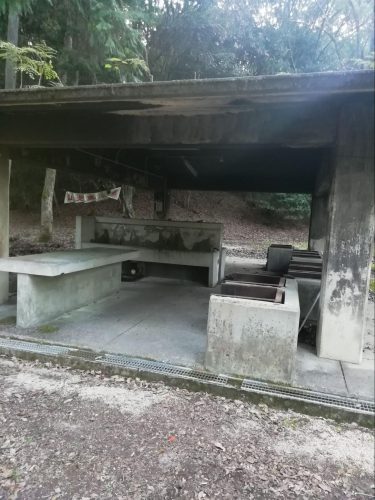
MY EXPERIENCE – AND THE DEER
So as I said earlier, I was there in off-peak fall season. I was worried about the cold, but caught a break in that the night I stayed was the warmest it had been in a week. I was layered, and chilled, but far less cold than I expected to be. So off-peak or not if you are not intimidated by the cold it might be possible to enjoy the site even into November, which is the peak season for seeing the autumn leaves. The campground, being a “natural park”, is surrounded by and filled with trees, and must be stunning in the late fall.
I got off the ferry and took the time to go see the great torii gate, buy some momiji-manju and deer poop ice cream (which became a foreshadowing of my camping experience9 and then headed to Tsutsumigaura. I carried only a sleeping back and backpack, and showed up at the front desk around 4 p.m. without a reservation. I had discreetly called earlier to assure that camping was still possible and tent rentals still available. I got myself a tent and directions to where the campsites are – a grove of trees about a 3-5 minute walk from the front desk, beyond the pond, cabins and tennis courts. Beyond that I was offered no assistance, except a reminder that the desk would close at 5 p.m., and a warning about the deer. More on that in a minute.
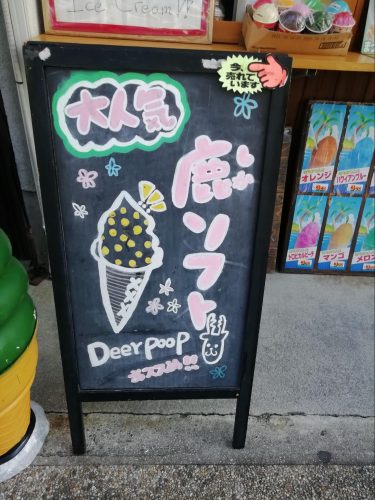
I found the location and despite not having camped in a tent in several decades, got the little two-person tent set up by myself in twenty minutes or less. It’s just a two-piece arched frame, then the tent is pulled up and connected by hooks. It was simple, and roomy enough inside, though definitely two-person max. I left my things inside and went to explore the site a little before dusk. Immediately upon exiting my tent I found a deer standing close by and observing. That reminded me of the site facilitator’s warning – “Close your tent if you happen to leave it. The deer will always be looking for food.”
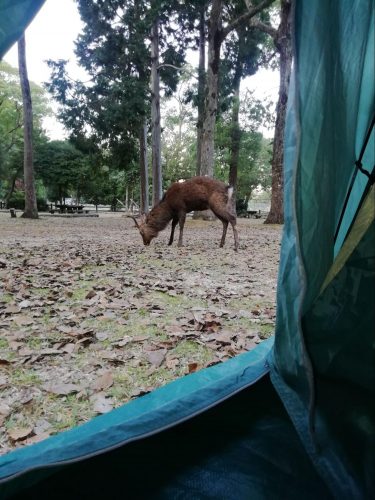
I pulled the zipper down on the flaps, and went to see what I could see. The pond is absolutely beautiful from many angles. The tennis courts impressively have both hard court and grass court options. The beachfront is sandy and probably great in the summer, and the view across to Hiroshima was wonderful. Heading back to my tent as night was falling was when I saw the twenty or more deer on the soccer field, which amusingly made me imagine I had just missed the actual game.
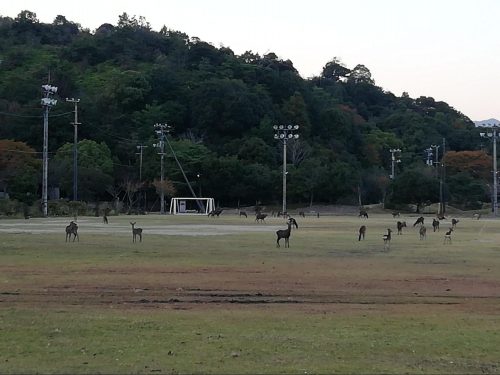
I had some food in my tent; I didn’t really want to barbeque alone. Then, I relaxed and looked at my smartphone and such. It was so dark by 7 p.m. that I felt it was surely 11 p.m. instead. The night sounds and dark trees made it quite peaceful. However, my phone battery was quite low and it was still early evening. The front desk had told me there was an outdoor outlet I could use to plug in my phone’s charger, so I went to do just that. I brought a book with me and sat at a picnic table under a light reading, with an ocean view and clear starry sky above. It was wonderful. There were, of course, yet more deer to be seen, including one young one that came and literally stood staring at the man reading a book for five minutes without moving.
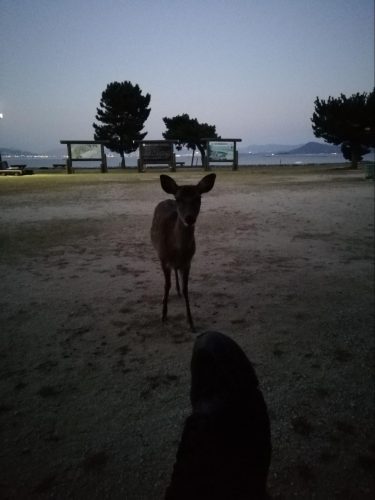
Finally feeling the cold, I grabbed my phone and charger and headed back to my tent. When leaving the tent I had indeed pulled down the inner flap zipper and also the outer flap zipper as warned. I had not, however, pulled the horizontal zipper at the bottom, as there was only a small opening, and these were deer not rabbits. My tent was surely safe.
Nope. One crazy deer had somehow managed to shove its head, and then its entire body into my tent through just that horizontal gap at the bottom. I have no idea how. I also have no idea how it would have gotten out again if I had not returned. Imagine my shock, though, when, in near darkness, I got back to my tent and heard noises inside even though the flaps were closed. I heard rustling and also chomping. I turned on my smartphone’s flashlight, opened both zippers, pulled the flap back while stepping out of the way, and then shone the light inside suddenly. Sure enough the deer bolted, and luckily through the opening I had just made. It did knock over my tent on its escape, however, so I then had to try and correct my tent and make it livable again, using only the light of my smartphone.
Luckily, the frame hadn’t come undone, so it was mostly just a matter of righting the tent and then stretching out the bottom tarp as much as possible. The tent pegs were torn up, too, but I found three in the dark at least. Also, luckily, I had not opened my sleeping bag yet at that point, so it wasn’t trampled on by deer hooves. In the end the only damage was some shredded newspaper pages and the loss of one entire bag of hard biscuits. That was the chomping I had heard. Also, three times during the night, after I had completely sealed myself in and gotten into my sleeping bag, I heard deer just outside the tent snuffling around looking for an opening. I had to slap my tent walls and give a shout to chase them away.
So it was a far more adventuresome night than I expected after the peaceful start. But as I opened with, communing with nature, and especially deer, is one of the draws of the Tsutsumigaura and I’ll be remembering my deer story for years and years to come. It was worth it.
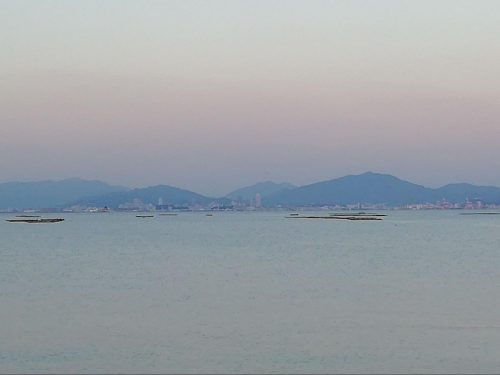
MOMENT OF JOY
First arrival at the site and seeing the beach front; my first view of the pond area; seeing my tent set up surrounded by trees and deer. There were many little moments of joy that all added up to one big joy, really. If I had to big the best, it would probably be seeing the moonshine on the water with Hiroshima lights off in the distance. Sadly, my smartphone was not capable of taking a good picture of it, but that view was definitely my moment of joy.
Tsutsumigaura Natural Park is simply a gorgeous place to do a little camping, with all the rest of Miyajima waiting just a short distance away as well. Highly recommended.
